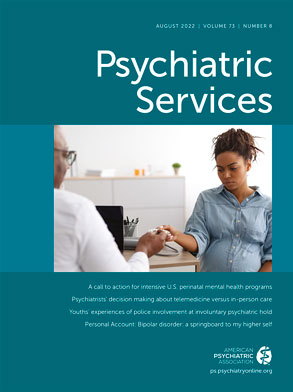CRANIUM was implemented at a large community mental health clinic between January 1 and December 31, 2015. A recent postdoctoral research project of merging data across several EHRs assessed the feasibility of implementation of this model in detail (data are available on request). We describe the successes and challenges of model implementation below.
Successes
The reverse-integration CRANIUM model focused on building workforce capacity—a priority recommended at a recent expert consensus panel (
3). Specifically, we focused on training and supports to accomplish selective task shifting from primary care to psychiatry. This component was further strengthened by the theoretical foundation of the intervention and a focus on psychiatrist behavior change. Additionally, psychiatrists and teams were encouraged both to screen and to follow up on positive screens, and prescribers were provided treatment algorithms and access to a primary care e-consultant to support this scope-of-practice expansion. All 10 providers reported that the intervention improved patient care and helped patients receive regular metabolic screening. Providers appreciated the treatment algorithms posted throughout the clinic and reported improved knowledge and confidence in treating metabolic abnormalities (data are available on request). The psychiatrists also appreciated the primary care e-consultant, as evidenced by the widespread use of this specialist (data are available on request).
This study was conducted in a clinical setting that exemplified typical challenges, including staff turnover and patients with complex conditions. Because providers often believe that psychiatric illness severity impedes treatment of cardiovascular disease risk factors (
4), our findings in this population are especially significant. Retention and engagement were high; there was no patient attrition, but two providers left the clinic during the study.
The intervention also appeared to affect patient-level outcomes, with modest increases in diabetes screening and more substantial increases in HIV testing (absolute increases from 1% to 17%; other data are available on request). Given the high prevalence of HIV risk factors and low HIV-testing rates in this population, we believe that these findings suggest that systemwide efforts to enhance cardiometabolic screening should include HIV testing.
Finally, the CRANIUM model appeared feasible for implementation in a community mental health setting, although further study should examine requirements to sustain the intervention and measure its longer-term impact. Treatment teams adopted the model’s major components, utilized the primary care e-consultant, hosted panel management meetings, utilized the registries, and developed plans to improve screening and initiate treatment with high fidelity (data available on request).
Challenges
Although the CRANIUM model enjoyed high levels of adoption in the clinic, several challenges limited its long-term success. First, the intervention, along with funding for the peer navigator and e-consultant, ended on study completion. As described elsewhere (
9), retaining and utilizing the peer navigator was more difficult than initially anticipated; we suggest that case managers complete laboratory forms, distribute maps to nearby laboratory services, and accompany patients for laboratory tests. In addition, having a full-time phlebotomist onsite for on-demand laboratory testing may be helpful.
Additionally, having existing staff perform study functions was costly. A cost analysis of the intervention was published previously (
10), finding that the CRANIUM intervention required approximately 45 hours of staff time and 1.5–2 hours per week of psychiatrist time per month. Unfortunately, aside from using the preexisting meeting time for panel management, we know little about how these time expenditures compared with those for work performed under “usual care” circumstances and how staff accommodated these additional duties. Future studies should compare this workflow with that of usual care. Given that we used process mapping and time-driven, activity-based cost to evaluate costs for CRANIUM—$74 per patient annually (
10)—future studies should conduct a comprehensive economic comparison. This comparison should include short-term costs related to screening and initial treatment of identified cardiovascular risk factors and long-term cost-effectiveness and variation by implementation challenges unique to the setting.
The generalizability of our findings to other settings is unknown. The psychiatrists in this setting may have been more willing to prescribe nonpsychotropic medications; previous work reports that some community psychiatrists have scope-of-practice concerns that make them reluctant to prescribe nonpsychotropic medications. Future studies should examine these and other medical-legal considerations in greater detail.
Although the CRANIUM model improved database management capacity (
3) by providing psychiatrists with the tools to identify individuals on their panel who needed screening, our previous work indicates that sourcing information from multiple EHRs takes significant staff time (
10). This expenditure likely affected registry maintenance after the study had ended and would be challenging for most clinics to replicate without additional funding. Additionally, some providers thought that the registry was difficult to integrate into practice, and others occasionally forgot to use the precompleted laboratory forms. With new technology, community mental health administrators may consider automatically preordering annual laboratory tests through the electronic system. Our study highlights how integrating EHR systems across community mental health and primary care settings is key to providing effective integrated care. We hope that by electronically merging records, registries will become easier to develop and maintain, enabling scalability and dissemination.
Although all teams used registries and reported following an action plan for missing laboratory results, only a modest increase in diabetes screening was observed (7% absolute increase). Furthermore, although several pre-post changes in screening rates were statistically significant, the overall absolute screening rates remained well below guideline recommendations. Because this population includes patients with very serious mental disorders, these limited improvements may have been a result of a focus on psychiatric treatment rather than primary care screening.
Additionally, data on treatment initiation were collected only qualitatively and did not assess the quality or outcomes of medical care at the clinic. Given that patient-level health outcomes represent a major gap in the literature on reverse-integration models (
3), future studies should examine the impact of this model on treatment initiation and other health outcomes.
Although we observed an increase in HIV testing, we identified important provider barriers to testing. Providers were concerned about the need for specialized informed consent, and some expressed their desire to risk-stratify for HIV risk behavior to inform screening decisions. These concerns sometimes caused providers to remove the HIV test from the laboratory forms. This practice is concerning, given that HIV testing no longer requires special informed consent, and providers are typically performing poorly at identifying sexual risk (
8).

